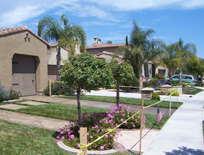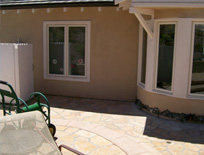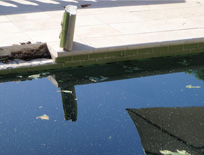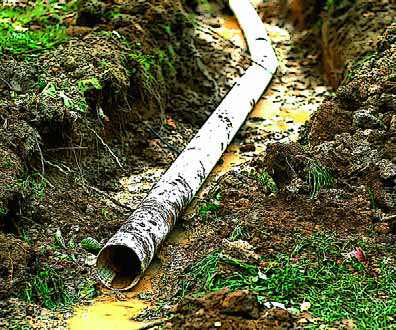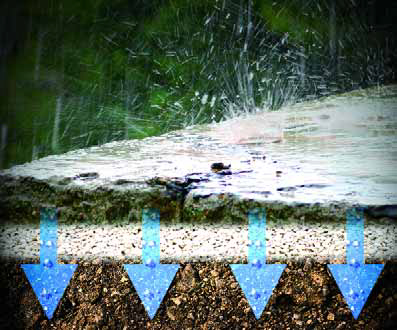Landscape, Plants, Hardscape & Decks
Among contractors, it’s not unusual to find those who don’t think much of their counterparts in other trades. That seems a bit sad, really, but there’s a reason for it: All too often, you run into situations in which
Every time I open a landscape trade magazine, I’m bombarded by ads from just about every paver manufacturer on the planet. From the newest faux-stone concrete pavers and ADA-compliant bricks to granite, flagstone, mica and other slab species, we have more choices than ever before for our projects. Some professionals approach this wealth of possibilities and play it safe – not caring so much about what’s the latest and greatest but focusing instead on what’s most familiar and time-tested and being interested in little more than providing clients with surfaces that can safely be walked on. Fortunately, however, there are lots of us who take a different view, putting care and thought into the materials we select for our walkways, patios and terraces and working closely with our clients to make certain the resulting surfaces meet their needs. In other words, there’s
Over the years, many of the mistakes I've seen that result in the most severe consequences can be remedied by very simple fixes. Indeed, the simplest and best "fix" is to avoid
For many of us in the custom watershape and landscape business these days, working with decorative concrete is an almost daily activity. In my business, for example, we custom-cast fountains, make poured-in-place coping, fabricate countertops, create pilaster caps — you name it. And we can make whatever
"A smart man learns from his own mistakes, a wise man learns from the mistakes of others." If you follow that Latin proverb, then you might conclude that the watershaping industry is populated by a fair number of smart people and a few wise ones. There are others out there, however, who
I’ve expended lots of ink in recent issues extolling the virtues of good water management, but that’s nothing new: Through the years, in fact, I’ve written copiously about the need for conservation and sensible stewardship of the most precious of our natural resources. And this all makes sense, given both the needs of our society and the fact that we who read and write for WaterShapes all derive some portion of our livings from the work we do with water. On those levels and more, water may be seen as our
Boston’s Big Dig was essentially a Big Fix. Officially known as the Central Artery Tunnel Project, it served to repair damage done to the heart of the city by the Interstate Highway program during the 1950s and ’60s. In Boston’s case, the federal government had stepped in and inserted a primary traffic artery through what had been a downtrodden area near the waterfront. Its intentions may have been good, but I-93 ran north to south and separated the city’s historic downtown area from its storied waterfront – a disastrous decision that did little more than create decades’ worth of traffic nightmares. Ultimately, it also required remediation on a scale seldom seen in the course of human history. Planning for the project began in 1982, initiating what would become
I’ve taken up a fair amount of my column space in WaterShapes with discussions of the wise use of water, and for good reason: What could be more important to watershapers than knowing how to make the best possible use of the material that defines our profession? And what could be better than the fact that it’s possible to approach the subject in positive ways that bode well for the future? The common thread in all of this coverage – whether it’s about conservation, constructed wetlands or rainwater harvesting – is that, ultimately, our aim must be to
Everything about this project was classic and beautiful. For one thing, the home has the soft look of a French country chateau. For another, it’s located in Hancock Park, one of the oldest of Los Angeles’ upscale downtown neighborhoods. And when you add in the fact that it sits on a half-acre-plus lot on a quiet street, we had the pleasing sense that we’d landed on a refreshing oasis at the heart of a bustling metropolis. We also enjoyed the privilege of working here with Andres Cardenes, a wonderful architect who had collaborated with these clients on and off for several years. In their latest endeavor, he had come in to refurbish the home along historic and formal lines – something that often happens in this neighborhood, which boasts numerous restored and beautifully maintained homes across a range of architectural styles. Our firm, New Leaf Landscape of Agoura Hills, Calif., had worked with Cardenes on previous projects. When he called, he talked a bit about the situation and let us know that he thought we’d be a great fit because of the way we
Not long ago, I did a pair of columns on healing gardens and their benefits. If you’ll recall, I preached the importance of persuading hospitals in particular to include these spaces in their overall site plans as a means of providing garden environments for patients, patients’ families and hospital staff: These spaces reduce stress, help patients heal more quickly and give everyone who visits them a soothing sense of tranquility. I’ve attempted to the greatest extent possible to practice what I preached, and through the years I’ve installed numerous health-specific gardens at local assisted-living centers, Alzheimer’s care facilities and even at a center for emotionally-challenged children. But truth be told, I haven’t met with much success with our local hospitals, despite the fact that healing gardens have caught on with countless such facilities coast to coast. I don’t know quite why this is, but we










